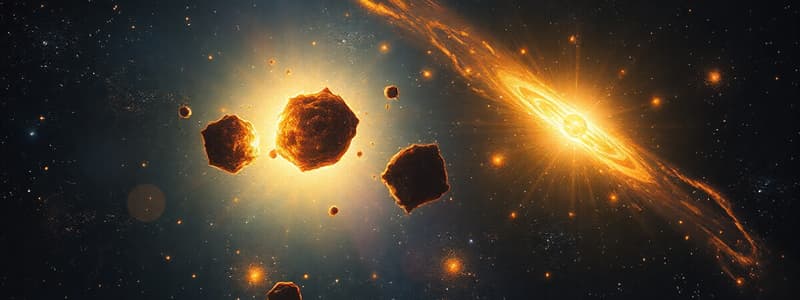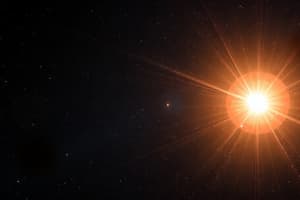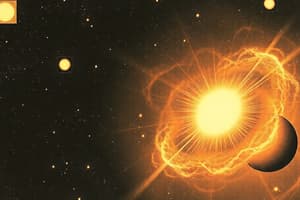Podcast
Questions and Answers
What is a nova outburst primarily characterized by?
What is a nova outburst primarily characterized by?
- A gradual dimming of a star's brightness
- A sudden increase in brightness in a binary star system (correct)
- The collapse of a supernova remnant
- The merging of two stars in a system
What two types of stars typically make up a binary star system that produces a nova?
What two types of stars typically make up a binary star system that produces a nova?
- A blue giant and a red supergiant
- A main sequence star and a brown dwarf
- A neutron star and a yellow dwarf
- A red giant and a white dwarf (correct)
How frequently does T Coronae Borealis experience nova outbursts?
How frequently does T Coronae Borealis experience nova outbursts?
- Every 100 years
- Every 80 years (correct)
- Every 10 years
- Every 50 years
What will the T Coronae Borealis nova eruption primarily look like from Earth?
What will the T Coronae Borealis nova eruption primarily look like from Earth?
What is the predicted visibility of the T Coronae Borealis nova explosion?
What is the predicted visibility of the T Coronae Borealis nova explosion?
What causes the buildup of material on the white dwarf in a binary star system?
What causes the buildup of material on the white dwarf in a binary star system?
What is the estimated distance of T Coronae Borealis from Earth?
What is the estimated distance of T Coronae Borealis from Earth?
What happens to the white dwarf after a nova event?
What happens to the white dwarf after a nova event?
Flashcards
What is a Nova?
What is a Nova?
A nova is a sudden and dramatic increase in brightness of a star, often appearing as a new bright star in the night sky.
How does a Nova occur?
How does a Nova occur?
A nova occurs in binary star systems where a red giant star sheds its outer layers onto a white dwarf star, causing the white dwarf's atmosphere to heat up and explode.
What is a Binary Star System?
What is a Binary Star System?
A binary star system consists of two stars orbiting around a common center of mass.
What is a Red Giant?
What is a Red Giant?
Signup and view all the flashcards
What is a White Dwarf?
What is a White Dwarf?
Signup and view all the flashcards
What is T Coronae Borealis?
What is T Coronae Borealis?
Signup and view all the flashcards
How will we see the 2024 Nova?
How will we see the 2024 Nova?
Signup and view all the flashcards
When will the 2024 Nova happen?
When will the 2024 Nova happen?
Signup and view all the flashcards
Study Notes
Nova Outburst Prediction
- A rare nova outburst is predicted by NASA sometime before September 2024.
- This event is observable from anywhere on Earth without specialized equipment.
- Unlike the April 2024 solar eclipse, this phenomenon is visible to the naked eye.
Nova Characteristics
- Novae occur in specific binary star systems.
- These systems comprise a red giant star (dying) and a white dwarf star (dead).
- Material from the red giant is shed and accumulates on the white dwarf.
- This accumulation triggers an explosive release of energy (nova).
- The outburst dramatically increases the star's brightness.
- Typically, novae require telescopes for visibility; the upcoming one is expected to be visible with the naked eye.
T Coronae Borealis Nova
- T Coronae Borealis (T CrB) is a binary star system 3,000 light-years away.
- T CrB is known for recurring nova outbursts, approximately every 80 years.
- The last outburst occurred in 1946.
- The next outburst may occur soon—within the next couple of months, possibly even tonight.
- The eruption will be visible to the naked eye for several days and with binoculars for over a week.
- The phenomenon will appear as a bright star in the northern sky.
- The white dwarf survives the nova outbursts, potentially to repeat the process.
Nova Formation Mechanism
- The tight orbit of the two stars in T CrB contributes to the outbursts.
- The red giant, as it heats, sheds its outer layers onto the white dwarf.
- Material buildup raises temperature and pressure on the white dwarf, causing a runaway reaction.
- The explosion is visible from Earth due to its brightness.
Studying That Suits You
Use AI to generate personalized quizzes and flashcards to suit your learning preferences.




